Sustainability in Public Sector Projects: A Detailed Analysis Report
VerifiedAdded on 2020/07/23
|13
|4319
|44
Report
AI Summary
This report provides a comprehensive analysis of sustainability within public sector projects, specifically focusing on Green Public Procurements in the United Kingdom. It explores project management methodologies, including Critical Path Methodologies, and examines various aspects of feasibility evaluation, planning, designing, and implementation. The report delves into the importance of sustainability in the context of the triple bottom line, emphasizing the integration of environmental, social, and financial considerations. It highlights the need for sustainability in the public sector to achieve long-term advantages, reduce costs, and enhance market positioning. The study covers the development of green procurement products, the setting of objectives, and the implementation of strategies to meet sustainability targets, with a focus on achieving environmental goals and supporting the UK's commitment to sustainable development. The report also analyzes the implementation of the Green Public Procurement plan, outlining the criteria for product and activity development and the targets set by the UK government for the adoption of green practices.
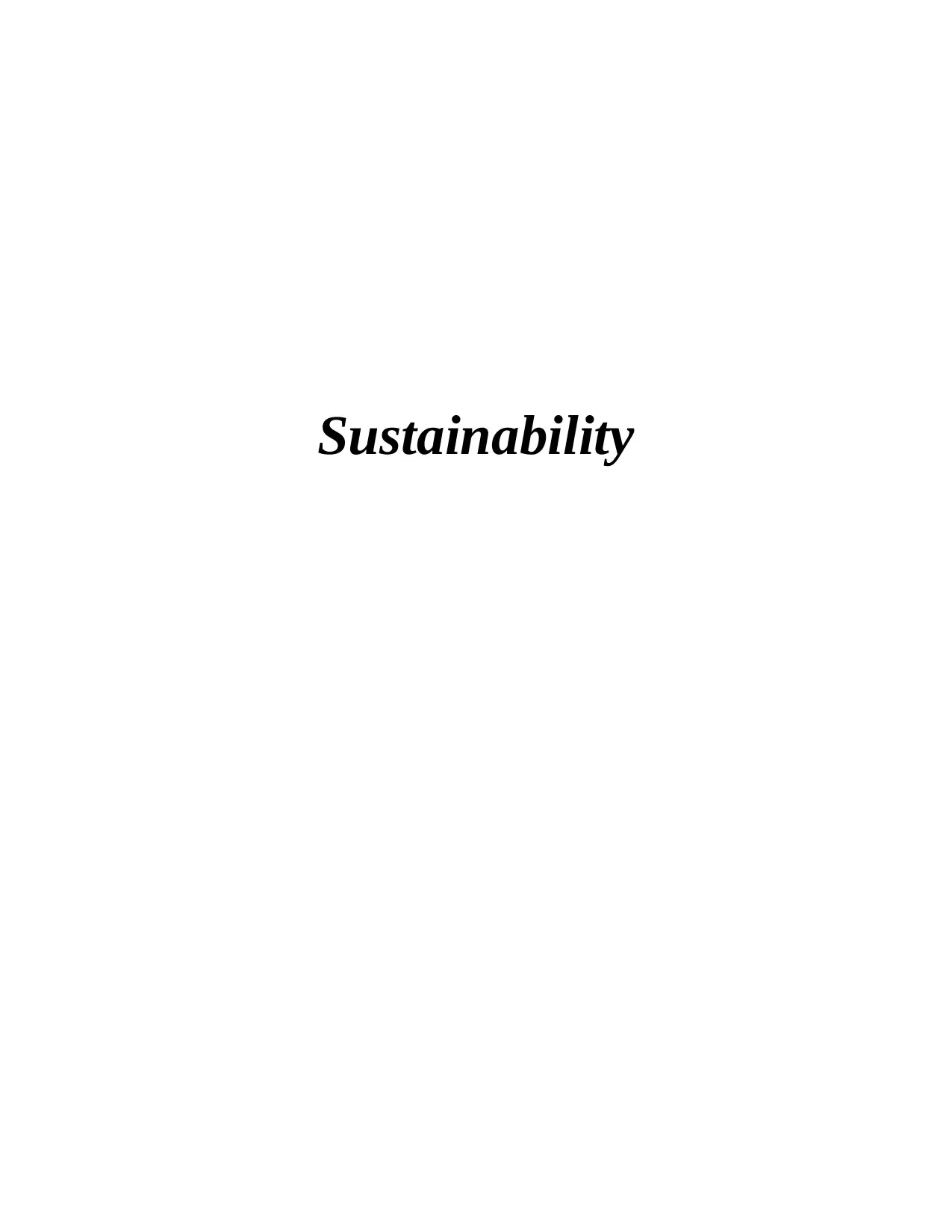
Sustainability
Paraphrase This Document
Need a fresh take? Get an instant paraphrase of this document with our AI Paraphraser
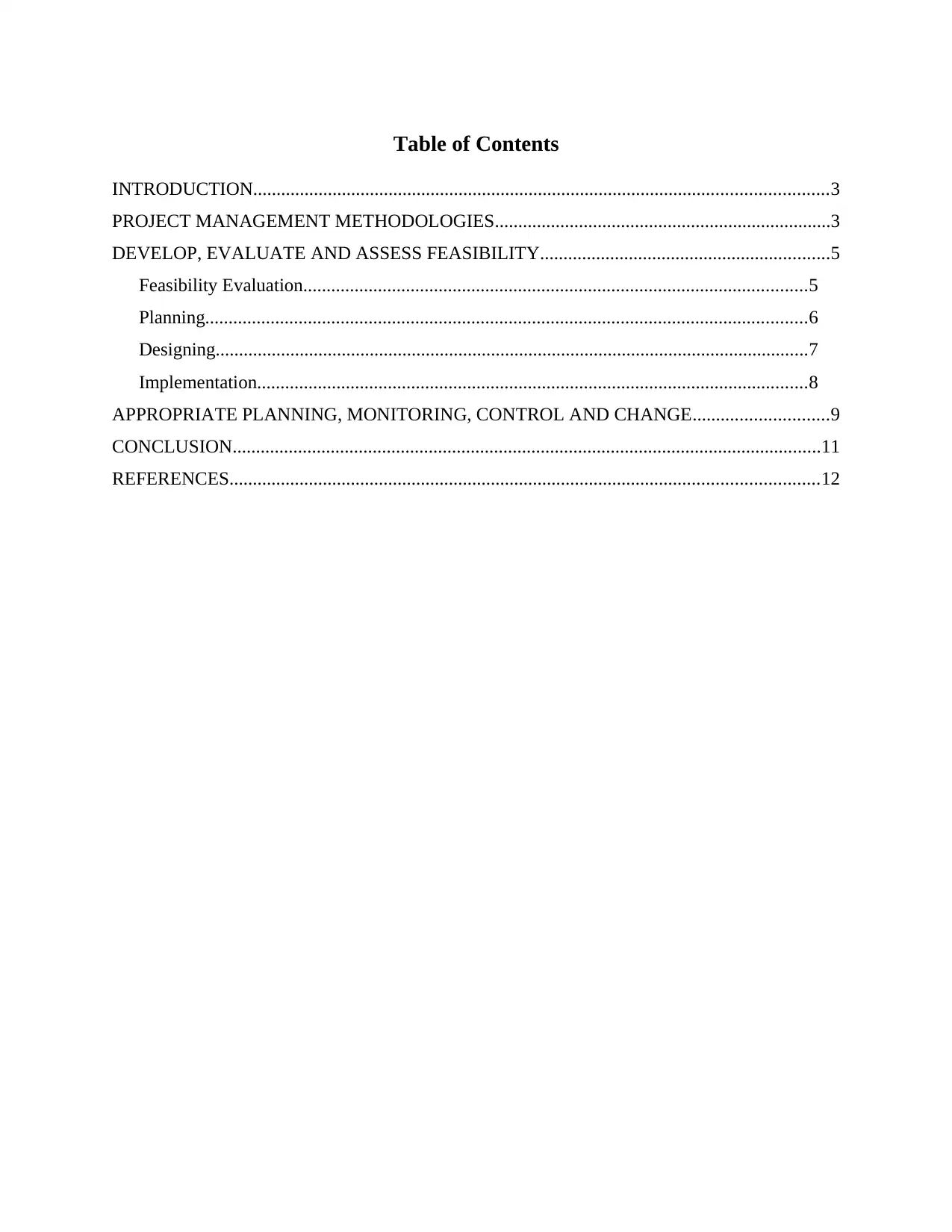
Table of Contents
INTRODUCTION...........................................................................................................................3
PROJECT MANAGEMENT METHODOLOGIES........................................................................3
DEVELOP, EVALUATE AND ASSESS FEASIBILITY..............................................................5
Feasibility Evaluation............................................................................................................5
Planning.................................................................................................................................6
Designing...............................................................................................................................7
Implementation......................................................................................................................8
APPROPRIATE PLANNING, MONITORING, CONTROL AND CHANGE.............................9
CONCLUSION..............................................................................................................................11
REFERENCES..............................................................................................................................12
INTRODUCTION...........................................................................................................................3
PROJECT MANAGEMENT METHODOLOGIES........................................................................3
DEVELOP, EVALUATE AND ASSESS FEASIBILITY..............................................................5
Feasibility Evaluation............................................................................................................5
Planning.................................................................................................................................6
Designing...............................................................................................................................7
Implementation......................................................................................................................8
APPROPRIATE PLANNING, MONITORING, CONTROL AND CHANGE.............................9
CONCLUSION..............................................................................................................................11
REFERENCES..............................................................................................................................12
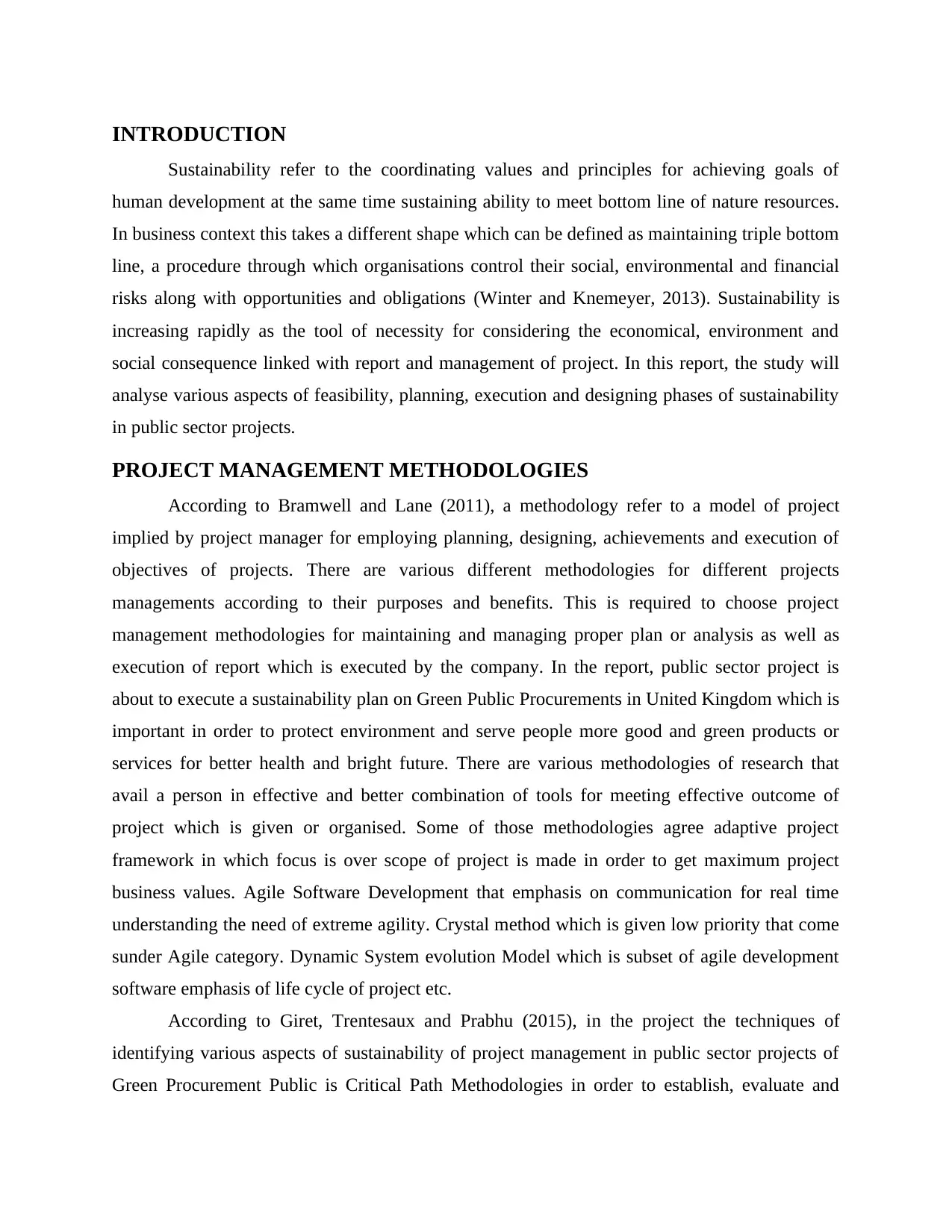
INTRODUCTION
Sustainability refer to the coordinating values and principles for achieving goals of
human development at the same time sustaining ability to meet bottom line of nature resources.
In business context this takes a different shape which can be defined as maintaining triple bottom
line, a procedure through which organisations control their social, environmental and financial
risks along with opportunities and obligations (Winter and Knemeyer, 2013). Sustainability is
increasing rapidly as the tool of necessity for considering the economical, environment and
social consequence linked with report and management of project. In this report, the study will
analyse various aspects of feasibility, planning, execution and designing phases of sustainability
in public sector projects.
PROJECT MANAGEMENT METHODOLOGIES
According to Bramwell and Lane (2011), a methodology refer to a model of project
implied by project manager for employing planning, designing, achievements and execution of
objectives of projects. There are various different methodologies for different projects
managements according to their purposes and benefits. This is required to choose project
management methodologies for maintaining and managing proper plan or analysis as well as
execution of report which is executed by the company. In the report, public sector project is
about to execute a sustainability plan on Green Public Procurements in United Kingdom which is
important in order to protect environment and serve people more good and green products or
services for better health and bright future. There are various methodologies of research that
avail a person in effective and better combination of tools for meeting effective outcome of
project which is given or organised. Some of those methodologies agree adaptive project
framework in which focus is over scope of project is made in order to get maximum project
business values. Agile Software Development that emphasis on communication for real time
understanding the need of extreme agility. Crystal method which is given low priority that come
sunder Agile category. Dynamic System evolution Model which is subset of agile development
software emphasis of life cycle of project etc.
According to Giret, Trentesaux and Prabhu (2015), in the project the techniques of
identifying various aspects of sustainability of project management in public sector projects of
Green Procurement Public is Critical Path Methodologies in order to establish, evaluate and
Sustainability refer to the coordinating values and principles for achieving goals of
human development at the same time sustaining ability to meet bottom line of nature resources.
In business context this takes a different shape which can be defined as maintaining triple bottom
line, a procedure through which organisations control their social, environmental and financial
risks along with opportunities and obligations (Winter and Knemeyer, 2013). Sustainability is
increasing rapidly as the tool of necessity for considering the economical, environment and
social consequence linked with report and management of project. In this report, the study will
analyse various aspects of feasibility, planning, execution and designing phases of sustainability
in public sector projects.
PROJECT MANAGEMENT METHODOLOGIES
According to Bramwell and Lane (2011), a methodology refer to a model of project
implied by project manager for employing planning, designing, achievements and execution of
objectives of projects. There are various different methodologies for different projects
managements according to their purposes and benefits. This is required to choose project
management methodologies for maintaining and managing proper plan or analysis as well as
execution of report which is executed by the company. In the report, public sector project is
about to execute a sustainability plan on Green Public Procurements in United Kingdom which is
important in order to protect environment and serve people more good and green products or
services for better health and bright future. There are various methodologies of research that
avail a person in effective and better combination of tools for meeting effective outcome of
project which is given or organised. Some of those methodologies agree adaptive project
framework in which focus is over scope of project is made in order to get maximum project
business values. Agile Software Development that emphasis on communication for real time
understanding the need of extreme agility. Crystal method which is given low priority that come
sunder Agile category. Dynamic System evolution Model which is subset of agile development
software emphasis of life cycle of project etc.
According to Giret, Trentesaux and Prabhu (2015), in the project the techniques of
identifying various aspects of sustainability of project management in public sector projects of
Green Procurement Public is Critical Path Methodologies in order to establish, evaluate and
⊘ This is a preview!⊘
Do you want full access?
Subscribe today to unlock all pages.

Trusted by 1+ million students worldwide
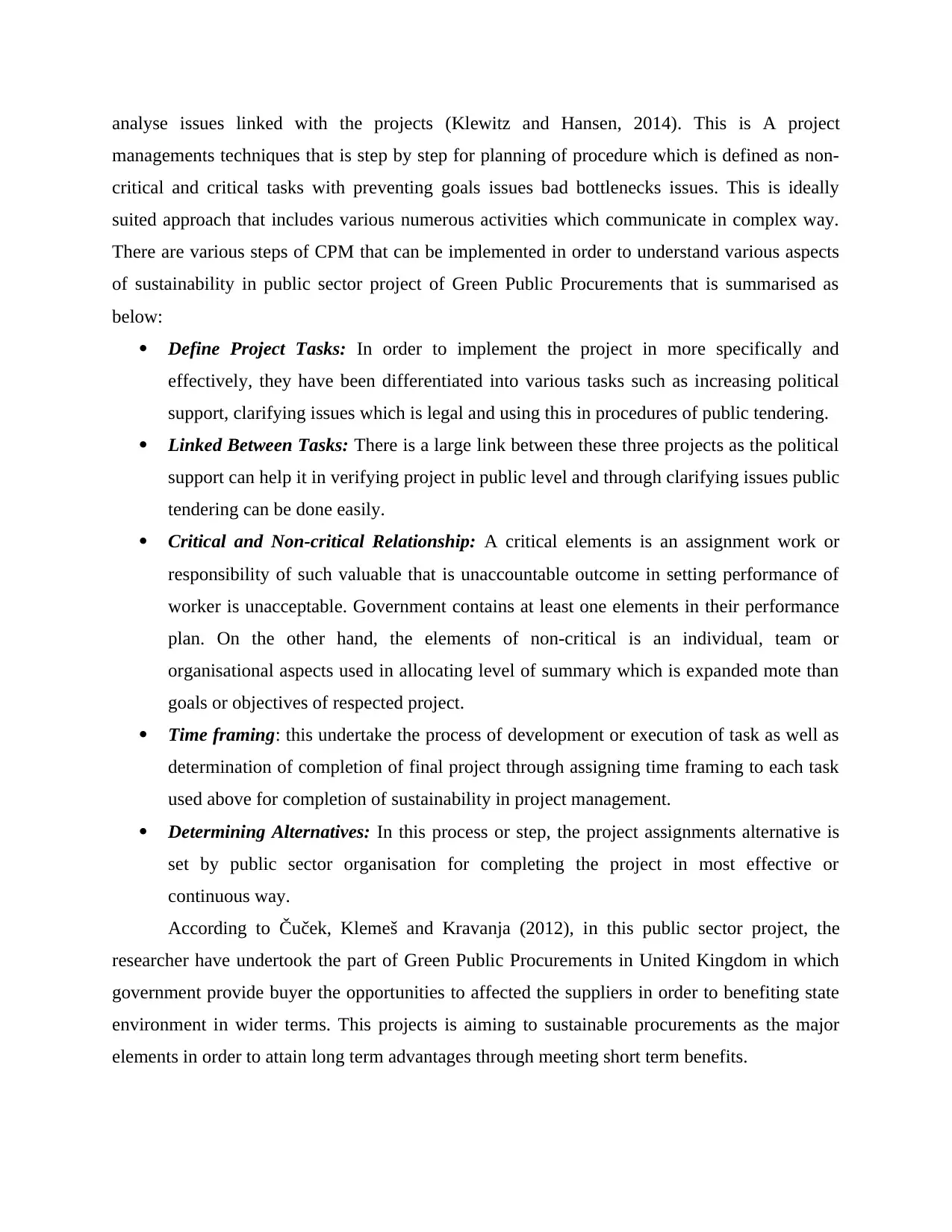
analyse issues linked with the projects (Klewitz and Hansen, 2014). This is A project
managements techniques that is step by step for planning of procedure which is defined as non-
critical and critical tasks with preventing goals issues bad bottlenecks issues. This is ideally
suited approach that includes various numerous activities which communicate in complex way.
There are various steps of CPM that can be implemented in order to understand various aspects
of sustainability in public sector project of Green Public Procurements that is summarised as
below:
Define Project Tasks: In order to implement the project in more specifically and
effectively, they have been differentiated into various tasks such as increasing political
support, clarifying issues which is legal and using this in procedures of public tendering.
Linked Between Tasks: There is a large link between these three projects as the political
support can help it in verifying project in public level and through clarifying issues public
tendering can be done easily.
Critical and Non-critical Relationship: A critical elements is an assignment work or
responsibility of such valuable that is unaccountable outcome in setting performance of
worker is unacceptable. Government contains at least one elements in their performance
plan. On the other hand, the elements of non-critical is an individual, team or
organisational aspects used in allocating level of summary which is expanded mote than
goals or objectives of respected project.
Time framing: this undertake the process of development or execution of task as well as
determination of completion of final project through assigning time framing to each task
used above for completion of sustainability in project management.
Determining Alternatives: In this process or step, the project assignments alternative is
set by public sector organisation for completing the project in most effective or
continuous way.
According to Čuček, Klemeš and Kravanja (2012), in this public sector project, the
researcher have undertook the part of Green Public Procurements in United Kingdom in which
government provide buyer the opportunities to affected the suppliers in order to benefiting state
environment in wider terms. This projects is aiming to sustainable procurements as the major
elements in order to attain long term advantages through meeting short term benefits.
managements techniques that is step by step for planning of procedure which is defined as non-
critical and critical tasks with preventing goals issues bad bottlenecks issues. This is ideally
suited approach that includes various numerous activities which communicate in complex way.
There are various steps of CPM that can be implemented in order to understand various aspects
of sustainability in public sector project of Green Public Procurements that is summarised as
below:
Define Project Tasks: In order to implement the project in more specifically and
effectively, they have been differentiated into various tasks such as increasing political
support, clarifying issues which is legal and using this in procedures of public tendering.
Linked Between Tasks: There is a large link between these three projects as the political
support can help it in verifying project in public level and through clarifying issues public
tendering can be done easily.
Critical and Non-critical Relationship: A critical elements is an assignment work or
responsibility of such valuable that is unaccountable outcome in setting performance of
worker is unacceptable. Government contains at least one elements in their performance
plan. On the other hand, the elements of non-critical is an individual, team or
organisational aspects used in allocating level of summary which is expanded mote than
goals or objectives of respected project.
Time framing: this undertake the process of development or execution of task as well as
determination of completion of final project through assigning time framing to each task
used above for completion of sustainability in project management.
Determining Alternatives: In this process or step, the project assignments alternative is
set by public sector organisation for completing the project in most effective or
continuous way.
According to Čuček, Klemeš and Kravanja (2012), in this public sector project, the
researcher have undertook the part of Green Public Procurements in United Kingdom in which
government provide buyer the opportunities to affected the suppliers in order to benefiting state
environment in wider terms. This projects is aiming to sustainable procurements as the major
elements in order to attain long term advantages through meeting short term benefits.
Paraphrase This Document
Need a fresh take? Get an instant paraphrase of this document with our AI Paraphraser
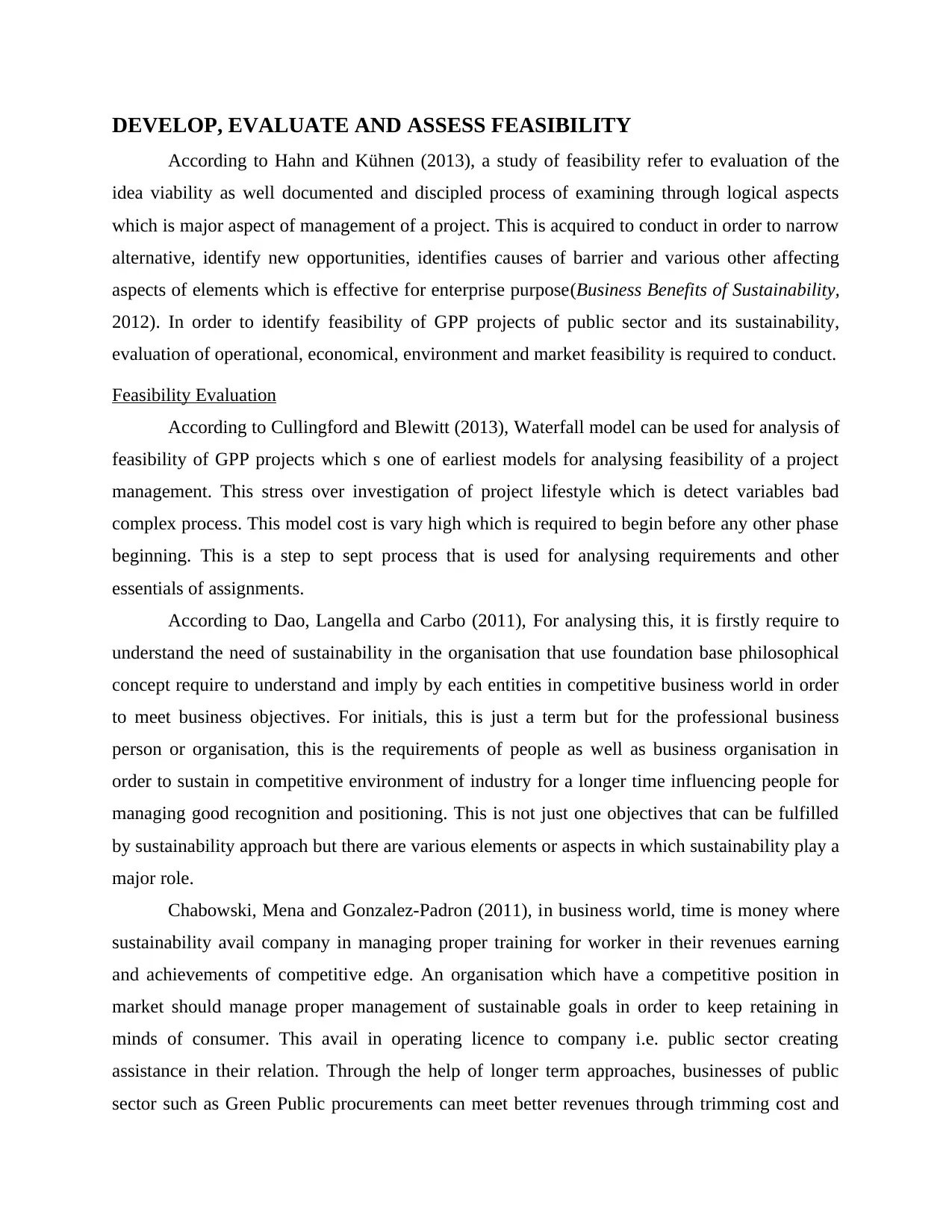
DEVELOP, EVALUATE AND ASSESS FEASIBILITY
According to Hahn and Kühnen (2013), a study of feasibility refer to evaluation of the
idea viability as well documented and discipled process of examining through logical aspects
which is major aspect of management of a project. This is acquired to conduct in order to narrow
alternative, identify new opportunities, identifies causes of barrier and various other affecting
aspects of elements which is effective for enterprise purpose(Business Benefits of Sustainability,
2012). In order to identify feasibility of GPP projects of public sector and its sustainability,
evaluation of operational, economical, environment and market feasibility is required to conduct.
Feasibility Evaluation
According to Cullingford and Blewitt (2013), Waterfall model can be used for analysis of
feasibility of GPP projects which s one of earliest models for analysing feasibility of a project
management. This stress over investigation of project lifestyle which is detect variables bad
complex process. This model cost is vary high which is required to begin before any other phase
beginning. This is a step to sept process that is used for analysing requirements and other
essentials of assignments.
According to Dao, Langella and Carbo (2011), For analysing this, it is firstly require to
understand the need of sustainability in the organisation that use foundation base philosophical
concept require to understand and imply by each entities in competitive business world in order
to meet business objectives. For initials, this is just a term but for the professional business
person or organisation, this is the requirements of people as well as business organisation in
order to sustain in competitive environment of industry for a longer time influencing people for
managing good recognition and positioning. This is not just one objectives that can be fulfilled
by sustainability approach but there are various elements or aspects in which sustainability play a
major role.
Chabowski, Mena and Gonzalez-Padron (2011), in business world, time is money where
sustainability avail company in managing proper training for worker in their revenues earning
and achievements of competitive edge. An organisation which have a competitive position in
market should manage proper management of sustainable goals in order to keep retaining in
minds of consumer. This avail in operating licence to company i.e. public sector creating
assistance in their relation. Through the help of longer term approaches, businesses of public
sector such as Green Public procurements can meet better revenues through trimming cost and
According to Hahn and Kühnen (2013), a study of feasibility refer to evaluation of the
idea viability as well documented and discipled process of examining through logical aspects
which is major aspect of management of a project. This is acquired to conduct in order to narrow
alternative, identify new opportunities, identifies causes of barrier and various other affecting
aspects of elements which is effective for enterprise purpose(Business Benefits of Sustainability,
2012). In order to identify feasibility of GPP projects of public sector and its sustainability,
evaluation of operational, economical, environment and market feasibility is required to conduct.
Feasibility Evaluation
According to Cullingford and Blewitt (2013), Waterfall model can be used for analysis of
feasibility of GPP projects which s one of earliest models for analysing feasibility of a project
management. This stress over investigation of project lifestyle which is detect variables bad
complex process. This model cost is vary high which is required to begin before any other phase
beginning. This is a step to sept process that is used for analysing requirements and other
essentials of assignments.
According to Dao, Langella and Carbo (2011), For analysing this, it is firstly require to
understand the need of sustainability in the organisation that use foundation base philosophical
concept require to understand and imply by each entities in competitive business world in order
to meet business objectives. For initials, this is just a term but for the professional business
person or organisation, this is the requirements of people as well as business organisation in
order to sustain in competitive environment of industry for a longer time influencing people for
managing good recognition and positioning. This is not just one objectives that can be fulfilled
by sustainability approach but there are various elements or aspects in which sustainability play a
major role.
Chabowski, Mena and Gonzalez-Padron (2011), in business world, time is money where
sustainability avail company in managing proper training for worker in their revenues earning
and achievements of competitive edge. An organisation which have a competitive position in
market should manage proper management of sustainable goals in order to keep retaining in
minds of consumer. This avail in operating licence to company i.e. public sector creating
assistance in their relation. Through the help of longer term approaches, businesses of public
sector such as Green Public procurements can meet better revenues through trimming cost and
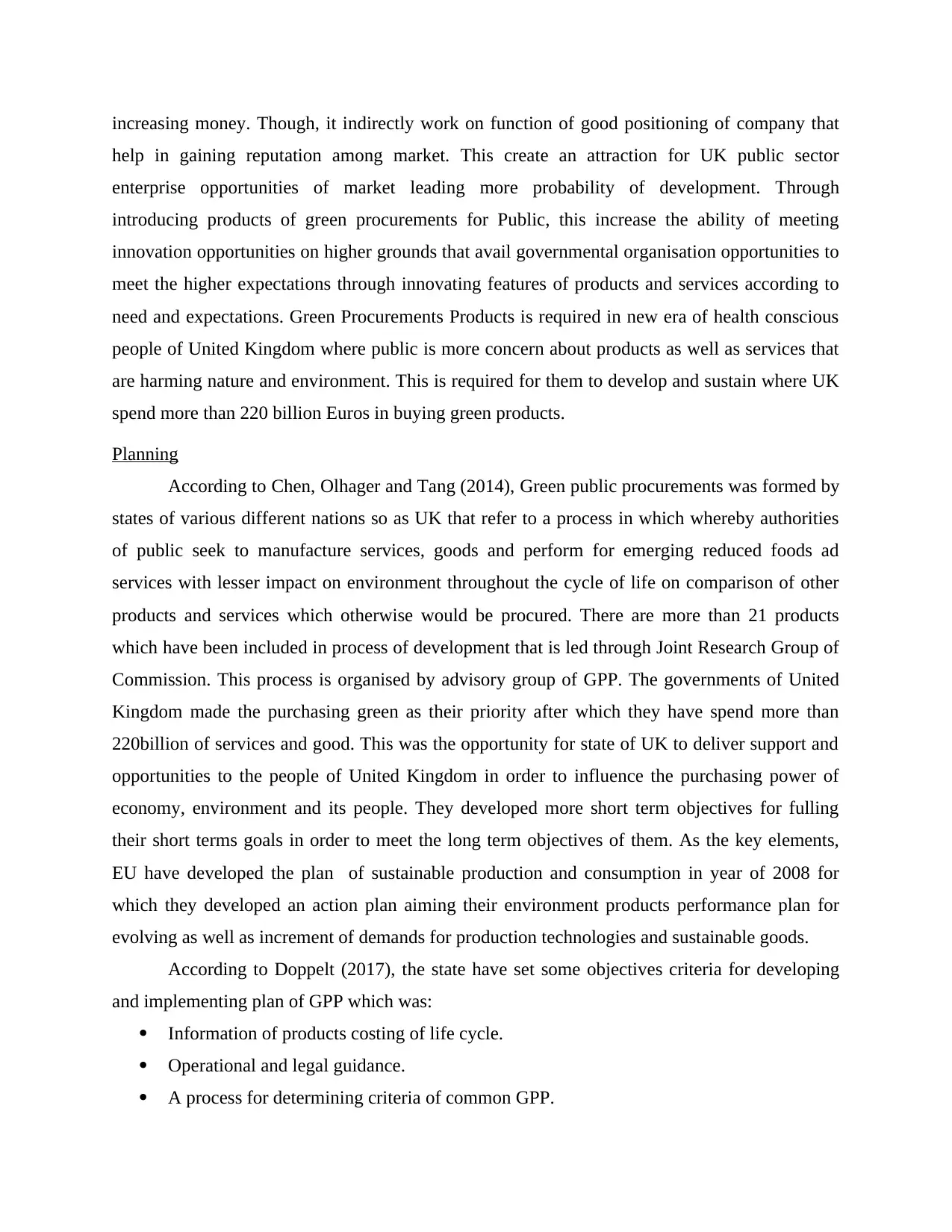
increasing money. Though, it indirectly work on function of good positioning of company that
help in gaining reputation among market. This create an attraction for UK public sector
enterprise opportunities of market leading more probability of development. Through
introducing products of green procurements for Public, this increase the ability of meeting
innovation opportunities on higher grounds that avail governmental organisation opportunities to
meet the higher expectations through innovating features of products and services according to
need and expectations. Green Procurements Products is required in new era of health conscious
people of United Kingdom where public is more concern about products as well as services that
are harming nature and environment. This is required for them to develop and sustain where UK
spend more than 220 billion Euros in buying green products.
Planning
According to Chen, Olhager and Tang (2014), Green public procurements was formed by
states of various different nations so as UK that refer to a process in which whereby authorities
of public seek to manufacture services, goods and perform for emerging reduced foods ad
services with lesser impact on environment throughout the cycle of life on comparison of other
products and services which otherwise would be procured. There are more than 21 products
which have been included in process of development that is led through Joint Research Group of
Commission. This process is organised by advisory group of GPP. The governments of United
Kingdom made the purchasing green as their priority after which they have spend more than
220billion of services and good. This was the opportunity for state of UK to deliver support and
opportunities to the people of United Kingdom in order to influence the purchasing power of
economy, environment and its people. They developed more short term objectives for fulling
their short terms goals in order to meet the long term objectives of them. As the key elements,
EU have developed the plan of sustainable production and consumption in year of 2008 for
which they developed an action plan aiming their environment products performance plan for
evolving as well as increment of demands for production technologies and sustainable goods.
According to Doppelt (2017), the state have set some objectives criteria for developing
and implementing plan of GPP which was:
Information of products costing of life cycle.
Operational and legal guidance.
A process for determining criteria of common GPP.
help in gaining reputation among market. This create an attraction for UK public sector
enterprise opportunities of market leading more probability of development. Through
introducing products of green procurements for Public, this increase the ability of meeting
innovation opportunities on higher grounds that avail governmental organisation opportunities to
meet the higher expectations through innovating features of products and services according to
need and expectations. Green Procurements Products is required in new era of health conscious
people of United Kingdom where public is more concern about products as well as services that
are harming nature and environment. This is required for them to develop and sustain where UK
spend more than 220 billion Euros in buying green products.
Planning
According to Chen, Olhager and Tang (2014), Green public procurements was formed by
states of various different nations so as UK that refer to a process in which whereby authorities
of public seek to manufacture services, goods and perform for emerging reduced foods ad
services with lesser impact on environment throughout the cycle of life on comparison of other
products and services which otherwise would be procured. There are more than 21 products
which have been included in process of development that is led through Joint Research Group of
Commission. This process is organised by advisory group of GPP. The governments of United
Kingdom made the purchasing green as their priority after which they have spend more than
220billion of services and good. This was the opportunity for state of UK to deliver support and
opportunities to the people of United Kingdom in order to influence the purchasing power of
economy, environment and its people. They developed more short term objectives for fulling
their short terms goals in order to meet the long term objectives of them. As the key elements,
EU have developed the plan of sustainable production and consumption in year of 2008 for
which they developed an action plan aiming their environment products performance plan for
evolving as well as increment of demands for production technologies and sustainable goods.
According to Doppelt (2017), the state have set some objectives criteria for developing
and implementing plan of GPP which was:
Information of products costing of life cycle.
Operational and legal guidance.
A process for determining criteria of common GPP.
⊘ This is a preview!⊘
Do you want full access?
Subscribe today to unlock all pages.

Trusted by 1+ million students worldwide
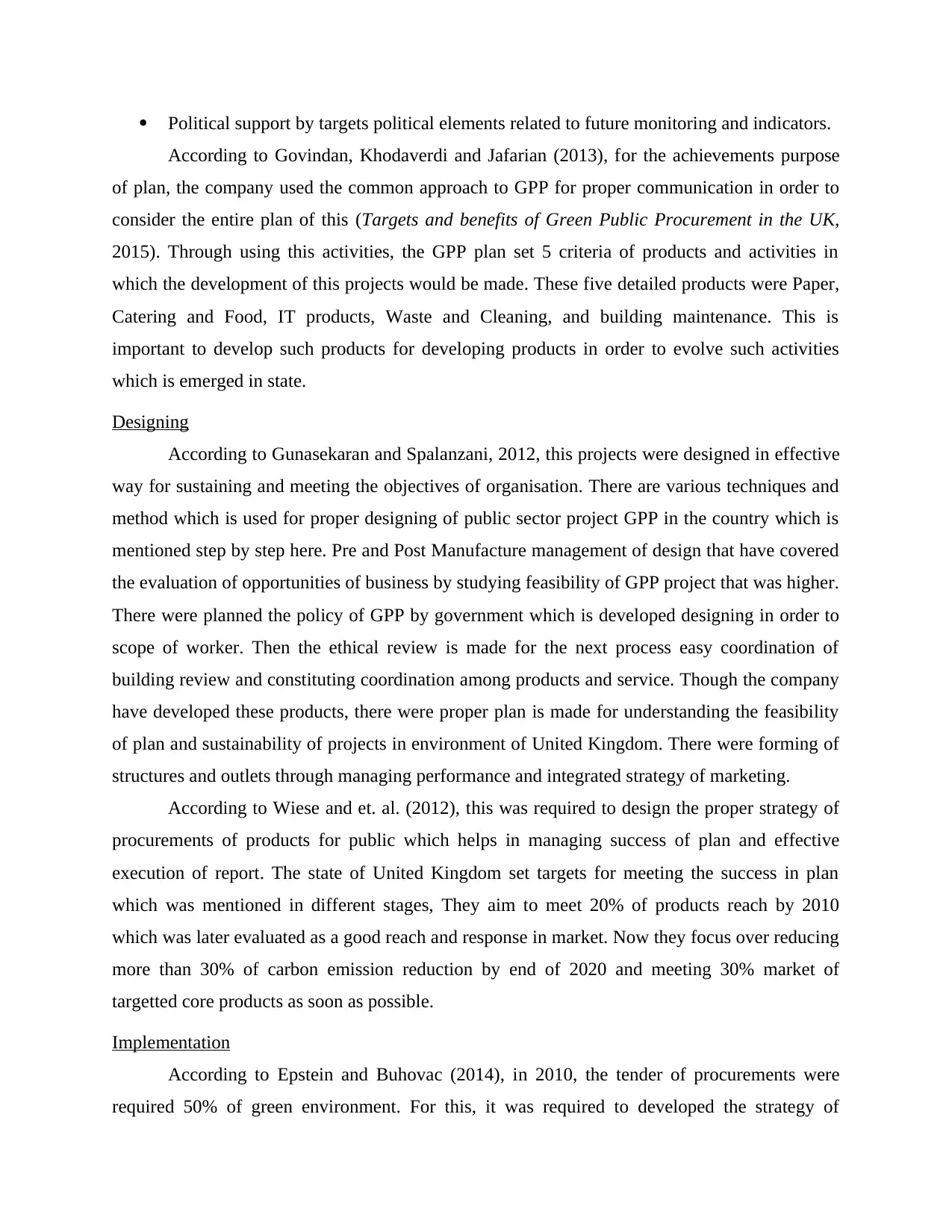
Political support by targets political elements related to future monitoring and indicators.
According to Govindan, Khodaverdi and Jafarian (2013), for the achievements purpose
of plan, the company used the common approach to GPP for proper communication in order to
consider the entire plan of this (Targets and benefits of Green Public Procurement in the UK,
2015). Through using this activities, the GPP plan set 5 criteria of products and activities in
which the development of this projects would be made. These five detailed products were Paper,
Catering and Food, IT products, Waste and Cleaning, and building maintenance. This is
important to develop such products for developing products in order to evolve such activities
which is emerged in state.
Designing
According to Gunasekaran and Spalanzani, 2012, this projects were designed in effective
way for sustaining and meeting the objectives of organisation. There are various techniques and
method which is used for proper designing of public sector project GPP in the country which is
mentioned step by step here. Pre and Post Manufacture management of design that have covered
the evaluation of opportunities of business by studying feasibility of GPP project that was higher.
There were planned the policy of GPP by government which is developed designing in order to
scope of worker. Then the ethical review is made for the next process easy coordination of
building review and constituting coordination among products and service. Though the company
have developed these products, there were proper plan is made for understanding the feasibility
of plan and sustainability of projects in environment of United Kingdom. There were forming of
structures and outlets through managing performance and integrated strategy of marketing.
According to Wiese and et. al. (2012), this was required to design the proper strategy of
procurements of products for public which helps in managing success of plan and effective
execution of report. The state of United Kingdom set targets for meeting the success in plan
which was mentioned in different stages, They aim to meet 20% of products reach by 2010
which was later evaluated as a good reach and response in market. Now they focus over reducing
more than 30% of carbon emission reduction by end of 2020 and meeting 30% market of
targetted core products as soon as possible.
Implementation
According to Epstein and Buhovac (2014), in 2010, the tender of procurements were
required 50% of green environment. For this, it was required to developed the strategy of
According to Govindan, Khodaverdi and Jafarian (2013), for the achievements purpose
of plan, the company used the common approach to GPP for proper communication in order to
consider the entire plan of this (Targets and benefits of Green Public Procurement in the UK,
2015). Through using this activities, the GPP plan set 5 criteria of products and activities in
which the development of this projects would be made. These five detailed products were Paper,
Catering and Food, IT products, Waste and Cleaning, and building maintenance. This is
important to develop such products for developing products in order to evolve such activities
which is emerged in state.
Designing
According to Gunasekaran and Spalanzani, 2012, this projects were designed in effective
way for sustaining and meeting the objectives of organisation. There are various techniques and
method which is used for proper designing of public sector project GPP in the country which is
mentioned step by step here. Pre and Post Manufacture management of design that have covered
the evaluation of opportunities of business by studying feasibility of GPP project that was higher.
There were planned the policy of GPP by government which is developed designing in order to
scope of worker. Then the ethical review is made for the next process easy coordination of
building review and constituting coordination among products and service. Though the company
have developed these products, there were proper plan is made for understanding the feasibility
of plan and sustainability of projects in environment of United Kingdom. There were forming of
structures and outlets through managing performance and integrated strategy of marketing.
According to Wiese and et. al. (2012), this was required to design the proper strategy of
procurements of products for public which helps in managing success of plan and effective
execution of report. The state of United Kingdom set targets for meeting the success in plan
which was mentioned in different stages, They aim to meet 20% of products reach by 2010
which was later evaluated as a good reach and response in market. Now they focus over reducing
more than 30% of carbon emission reduction by end of 2020 and meeting 30% market of
targetted core products as soon as possible.
Implementation
According to Epstein and Buhovac (2014), in 2010, the tender of procurements were
required 50% of green environment. For this, it was required to developed the strategy of
Paraphrase This Document
Need a fresh take? Get an instant paraphrase of this document with our AI Paraphraser
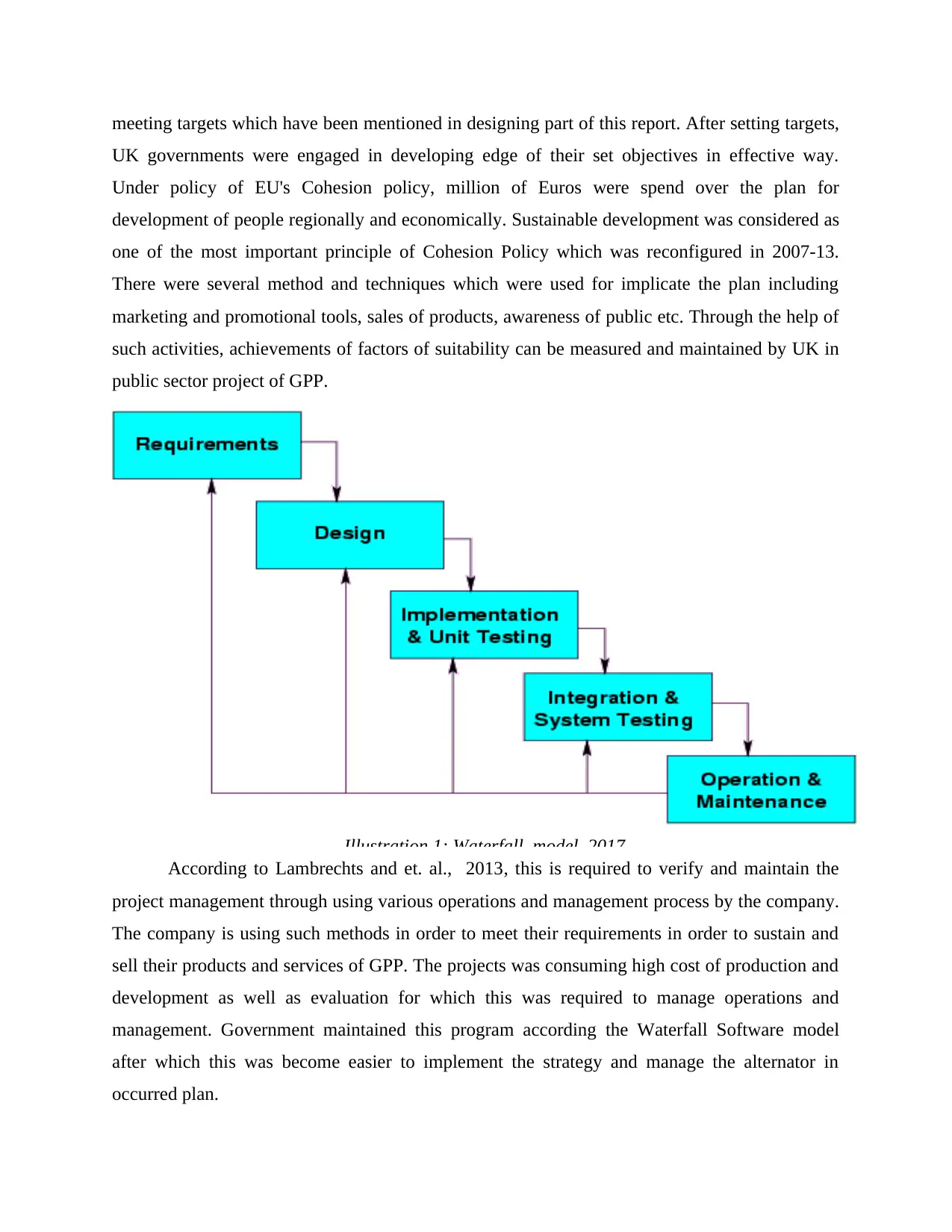
meeting targets which have been mentioned in designing part of this report. After setting targets,
UK governments were engaged in developing edge of their set objectives in effective way.
Under policy of EU's Cohesion policy, million of Euros were spend over the plan for
development of people regionally and economically. Sustainable development was considered as
one of the most important principle of Cohesion Policy which was reconfigured in 2007-13.
There were several method and techniques which were used for implicate the plan including
marketing and promotional tools, sales of products, awareness of public etc. Through the help of
such activities, achievements of factors of suitability can be measured and maintained by UK in
public sector project of GPP.
Illustration 1: Waterfall model, 2017
According to Lambrechts and et. al., 2013, this is required to verify and maintain the
project management through using various operations and management process by the company.
The company is using such methods in order to meet their requirements in order to sustain and
sell their products and services of GPP. The projects was consuming high cost of production and
development as well as evaluation for which this was required to manage operations and
management. Government maintained this program according the Waterfall Software model
after which this was become easier to implement the strategy and manage the alternator in
occurred plan.
UK governments were engaged in developing edge of their set objectives in effective way.
Under policy of EU's Cohesion policy, million of Euros were spend over the plan for
development of people regionally and economically. Sustainable development was considered as
one of the most important principle of Cohesion Policy which was reconfigured in 2007-13.
There were several method and techniques which were used for implicate the plan including
marketing and promotional tools, sales of products, awareness of public etc. Through the help of
such activities, achievements of factors of suitability can be measured and maintained by UK in
public sector project of GPP.
Illustration 1: Waterfall model, 2017
According to Lambrechts and et. al., 2013, this is required to verify and maintain the
project management through using various operations and management process by the company.
The company is using such methods in order to meet their requirements in order to sustain and
sell their products and services of GPP. The projects was consuming high cost of production and
development as well as evaluation for which this was required to manage operations and
management. Government maintained this program according the Waterfall Software model
after which this was become easier to implement the strategy and manage the alternator in
occurred plan.
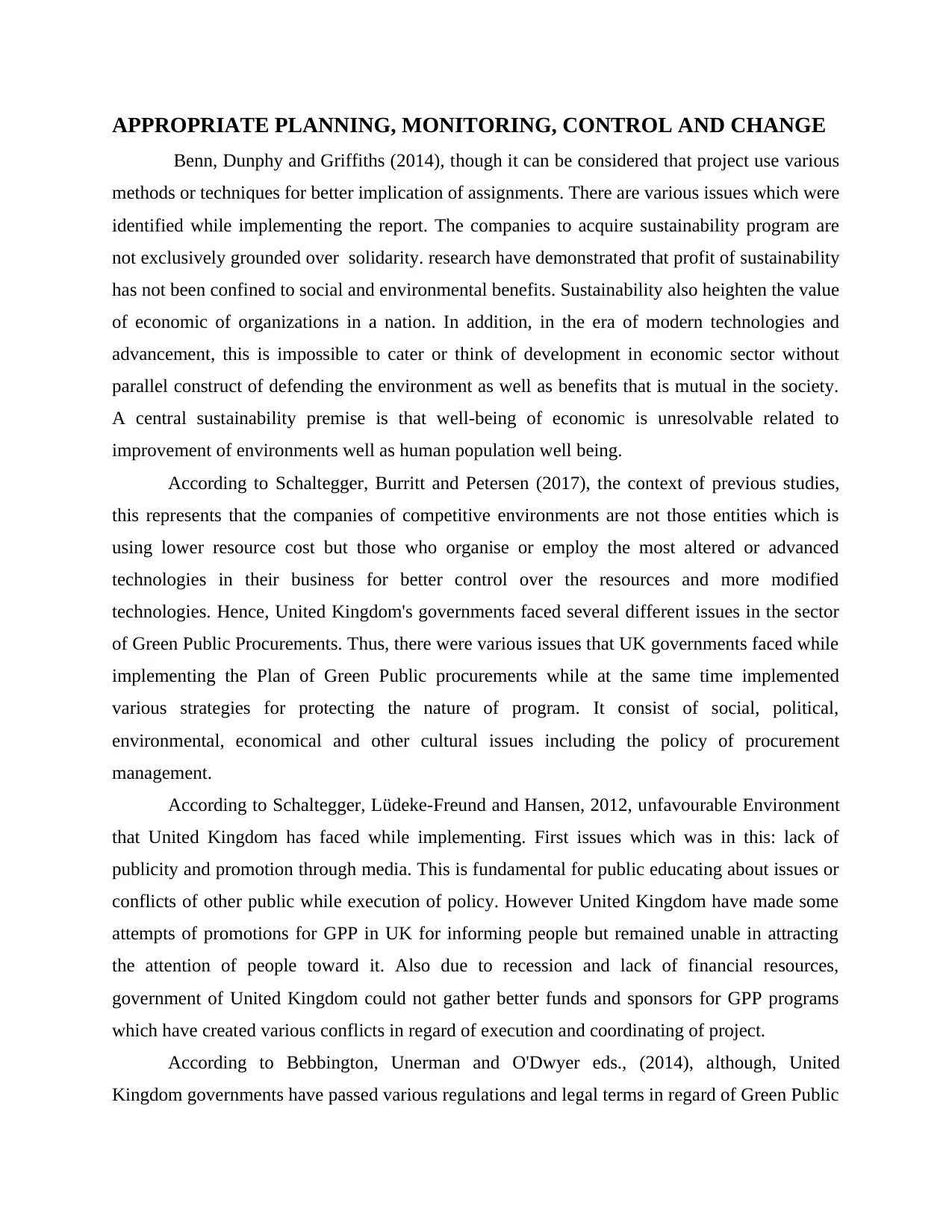
APPROPRIATE PLANNING, MONITORING, CONTROL AND CHANGE
Benn, Dunphy and Griffiths (2014), though it can be considered that project use various
methods or techniques for better implication of assignments. There are various issues which were
identified while implementing the report. The companies to acquire sustainability program are
not exclusively grounded over solidarity. research have demonstrated that profit of sustainability
has not been confined to social and environmental benefits. Sustainability also heighten the value
of economic of organizations in a nation. In addition, in the era of modern technologies and
advancement, this is impossible to cater or think of development in economic sector without
parallel construct of defending the environment as well as benefits that is mutual in the society.
A central sustainability premise is that well-being of economic is unresolvable related to
improvement of environments well as human population well being.
According to Schaltegger, Burritt and Petersen (2017), the context of previous studies,
this represents that the companies of competitive environments are not those entities which is
using lower resource cost but those who organise or employ the most altered or advanced
technologies in their business for better control over the resources and more modified
technologies. Hence, United Kingdom's governments faced several different issues in the sector
of Green Public Procurements. Thus, there were various issues that UK governments faced while
implementing the Plan of Green Public procurements while at the same time implemented
various strategies for protecting the nature of program. It consist of social, political,
environmental, economical and other cultural issues including the policy of procurement
management.
According to Schaltegger, Lüdeke-Freund and Hansen, 2012, unfavourable Environment
that United Kingdom has faced while implementing. First issues which was in this: lack of
publicity and promotion through media. This is fundamental for public educating about issues or
conflicts of other public while execution of policy. However United Kingdom have made some
attempts of promotions for GPP in UK for informing people but remained unable in attracting
the attention of people toward it. Also due to recession and lack of financial resources,
government of United Kingdom could not gather better funds and sponsors for GPP programs
which have created various conflicts in regard of execution and coordinating of project.
According to Bebbington, Unerman and O'Dwyer eds., (2014), although, United
Kingdom governments have passed various regulations and legal terms in regard of Green Public
Benn, Dunphy and Griffiths (2014), though it can be considered that project use various
methods or techniques for better implication of assignments. There are various issues which were
identified while implementing the report. The companies to acquire sustainability program are
not exclusively grounded over solidarity. research have demonstrated that profit of sustainability
has not been confined to social and environmental benefits. Sustainability also heighten the value
of economic of organizations in a nation. In addition, in the era of modern technologies and
advancement, this is impossible to cater or think of development in economic sector without
parallel construct of defending the environment as well as benefits that is mutual in the society.
A central sustainability premise is that well-being of economic is unresolvable related to
improvement of environments well as human population well being.
According to Schaltegger, Burritt and Petersen (2017), the context of previous studies,
this represents that the companies of competitive environments are not those entities which is
using lower resource cost but those who organise or employ the most altered or advanced
technologies in their business for better control over the resources and more modified
technologies. Hence, United Kingdom's governments faced several different issues in the sector
of Green Public Procurements. Thus, there were various issues that UK governments faced while
implementing the Plan of Green Public procurements while at the same time implemented
various strategies for protecting the nature of program. It consist of social, political,
environmental, economical and other cultural issues including the policy of procurement
management.
According to Schaltegger, Lüdeke-Freund and Hansen, 2012, unfavourable Environment
that United Kingdom has faced while implementing. First issues which was in this: lack of
publicity and promotion through media. This is fundamental for public educating about issues or
conflicts of other public while execution of policy. However United Kingdom have made some
attempts of promotions for GPP in UK for informing people but remained unable in attracting
the attention of people toward it. Also due to recession and lack of financial resources,
government of United Kingdom could not gather better funds and sponsors for GPP programs
which have created various conflicts in regard of execution and coordinating of project.
According to Bebbington, Unerman and O'Dwyer eds., (2014), although, United
Kingdom governments have passed various regulations and legal terms in regard of Green Public
⊘ This is a preview!⊘
Do you want full access?
Subscribe today to unlock all pages.

Trusted by 1+ million students worldwide
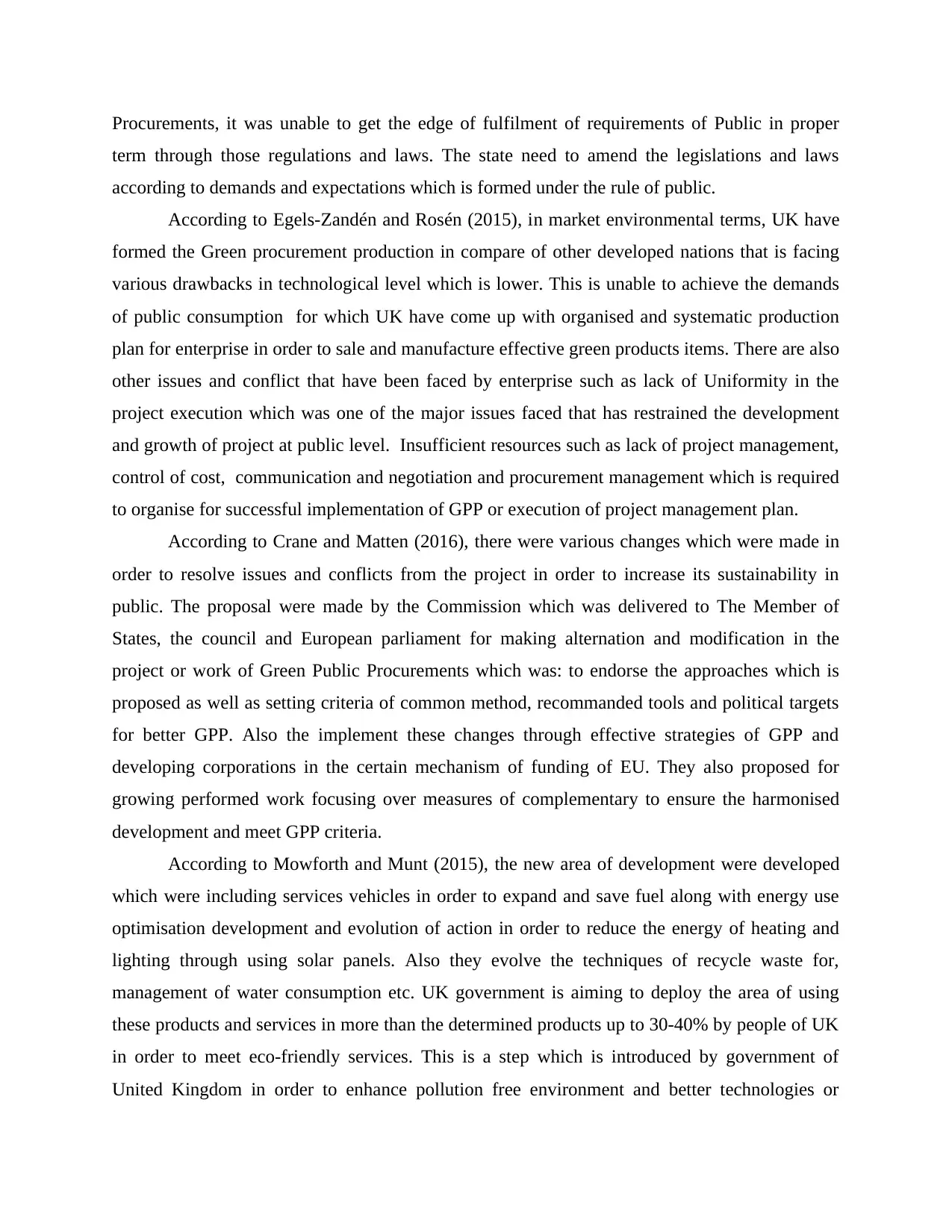
Procurements, it was unable to get the edge of fulfilment of requirements of Public in proper
term through those regulations and laws. The state need to amend the legislations and laws
according to demands and expectations which is formed under the rule of public.
According to Egels-Zandén and Rosén (2015), in market environmental terms, UK have
formed the Green procurement production in compare of other developed nations that is facing
various drawbacks in technological level which is lower. This is unable to achieve the demands
of public consumption for which UK have come up with organised and systematic production
plan for enterprise in order to sale and manufacture effective green products items. There are also
other issues and conflict that have been faced by enterprise such as lack of Uniformity in the
project execution which was one of the major issues faced that has restrained the development
and growth of project at public level. Insufficient resources such as lack of project management,
control of cost, communication and negotiation and procurement management which is required
to organise for successful implementation of GPP or execution of project management plan.
According to Crane and Matten (2016), there were various changes which were made in
order to resolve issues and conflicts from the project in order to increase its sustainability in
public. The proposal were made by the Commission which was delivered to The Member of
States, the council and European parliament for making alternation and modification in the
project or work of Green Public Procurements which was: to endorse the approaches which is
proposed as well as setting criteria of common method, recommanded tools and political targets
for better GPP. Also the implement these changes through effective strategies of GPP and
developing corporations in the certain mechanism of funding of EU. They also proposed for
growing performed work focusing over measures of complementary to ensure the harmonised
development and meet GPP criteria.
According to Mowforth and Munt (2015), the new area of development were developed
which were including services vehicles in order to expand and save fuel along with energy use
optimisation development and evolution of action in order to reduce the energy of heating and
lighting through using solar panels. Also they evolve the techniques of recycle waste for,
management of water consumption etc. UK government is aiming to deploy the area of using
these products and services in more than the determined products up to 30-40% by people of UK
in order to meet eco-friendly services. This is a step which is introduced by government of
United Kingdom in order to enhance pollution free environment and better technologies or
term through those regulations and laws. The state need to amend the legislations and laws
according to demands and expectations which is formed under the rule of public.
According to Egels-Zandén and Rosén (2015), in market environmental terms, UK have
formed the Green procurement production in compare of other developed nations that is facing
various drawbacks in technological level which is lower. This is unable to achieve the demands
of public consumption for which UK have come up with organised and systematic production
plan for enterprise in order to sale and manufacture effective green products items. There are also
other issues and conflict that have been faced by enterprise such as lack of Uniformity in the
project execution which was one of the major issues faced that has restrained the development
and growth of project at public level. Insufficient resources such as lack of project management,
control of cost, communication and negotiation and procurement management which is required
to organise for successful implementation of GPP or execution of project management plan.
According to Crane and Matten (2016), there were various changes which were made in
order to resolve issues and conflicts from the project in order to increase its sustainability in
public. The proposal were made by the Commission which was delivered to The Member of
States, the council and European parliament for making alternation and modification in the
project or work of Green Public Procurements which was: to endorse the approaches which is
proposed as well as setting criteria of common method, recommanded tools and political targets
for better GPP. Also the implement these changes through effective strategies of GPP and
developing corporations in the certain mechanism of funding of EU. They also proposed for
growing performed work focusing over measures of complementary to ensure the harmonised
development and meet GPP criteria.
According to Mowforth and Munt (2015), the new area of development were developed
which were including services vehicles in order to expand and save fuel along with energy use
optimisation development and evolution of action in order to reduce the energy of heating and
lighting through using solar panels. Also they evolve the techniques of recycle waste for,
management of water consumption etc. UK government is aiming to deploy the area of using
these products and services in more than the determined products up to 30-40% by people of UK
in order to meet eco-friendly services. This is a step which is introduced by government of
United Kingdom in order to enhance pollution free environment and better technologies or
Paraphrase This Document
Need a fresh take? Get an instant paraphrase of this document with our AI Paraphraser
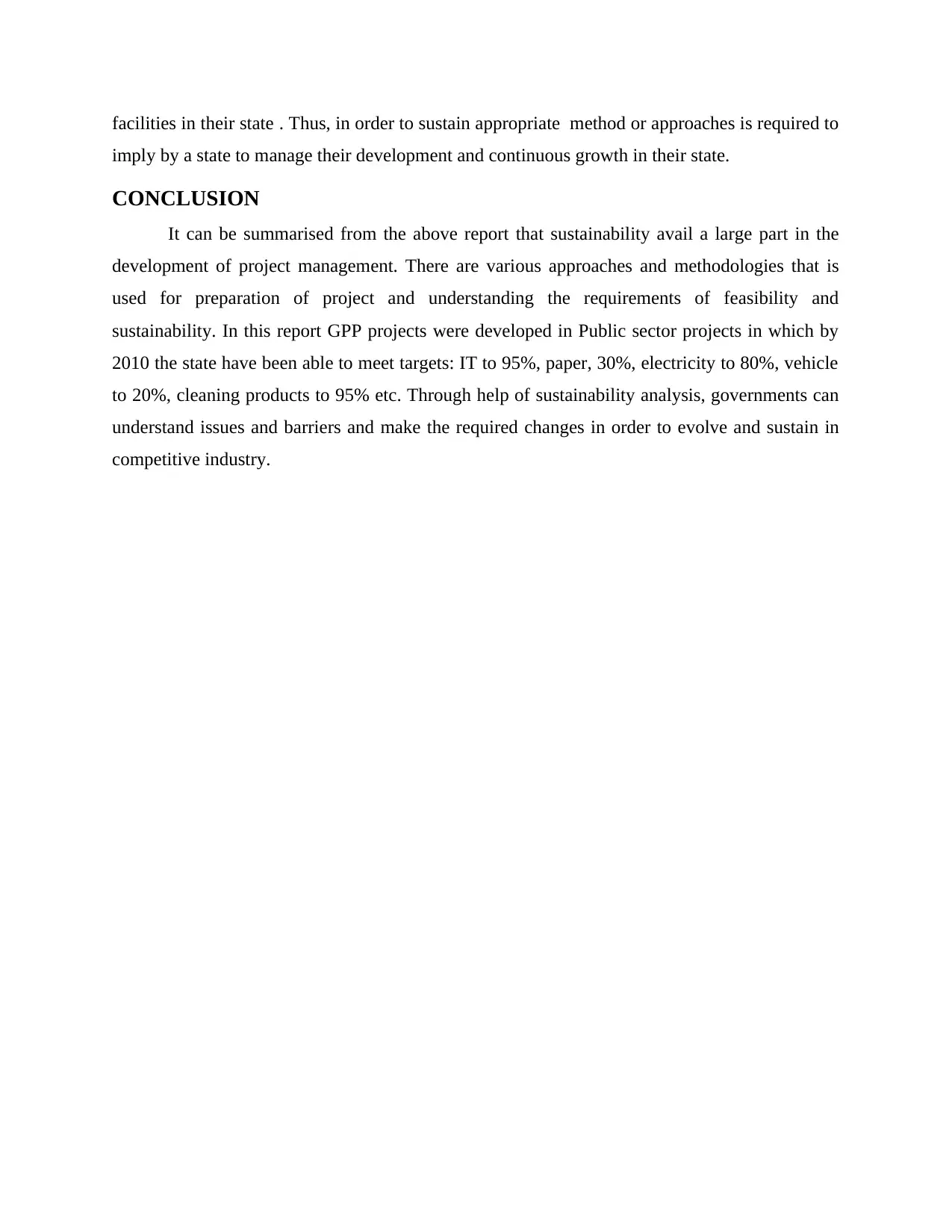
facilities in their state . Thus, in order to sustain appropriate method or approaches is required to
imply by a state to manage their development and continuous growth in their state.
CONCLUSION
It can be summarised from the above report that sustainability avail a large part in the
development of project management. There are various approaches and methodologies that is
used for preparation of project and understanding the requirements of feasibility and
sustainability. In this report GPP projects were developed in Public sector projects in which by
2010 the state have been able to meet targets: IT to 95%, paper, 30%, electricity to 80%, vehicle
to 20%, cleaning products to 95% etc. Through help of sustainability analysis, governments can
understand issues and barriers and make the required changes in order to evolve and sustain in
competitive industry.
imply by a state to manage their development and continuous growth in their state.
CONCLUSION
It can be summarised from the above report that sustainability avail a large part in the
development of project management. There are various approaches and methodologies that is
used for preparation of project and understanding the requirements of feasibility and
sustainability. In this report GPP projects were developed in Public sector projects in which by
2010 the state have been able to meet targets: IT to 95%, paper, 30%, electricity to 80%, vehicle
to 20%, cleaning products to 95% etc. Through help of sustainability analysis, governments can
understand issues and barriers and make the required changes in order to evolve and sustain in
competitive industry.
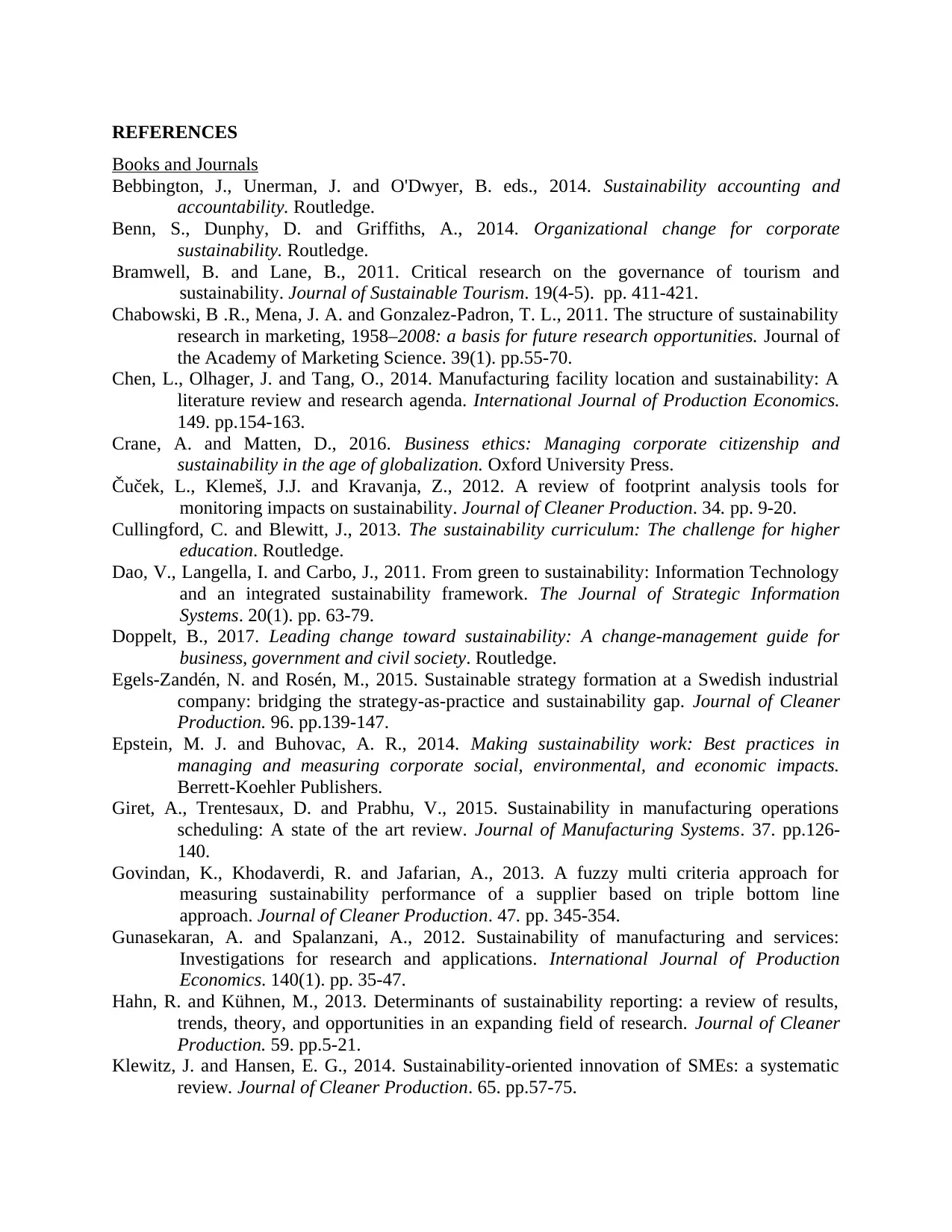
REFERENCES
Books and Journals
Bebbington, J., Unerman, J. and O'Dwyer, B. eds., 2014. Sustainability accounting and
accountability. Routledge.
Benn, S., Dunphy, D. and Griffiths, A., 2014. Organizational change for corporate
sustainability. Routledge.
Bramwell, B. and Lane, B., 2011. Critical research on the governance of tourism and
sustainability. Journal of Sustainable Tourism. 19(4-5). pp. 411-421.
Chabowski, B .R., Mena, J. A. and Gonzalez-Padron, T. L., 2011. The structure of sustainability
research in marketing, 1958–2008: a basis for future research opportunities. Journal of
the Academy of Marketing Science. 39(1). pp.55-70.
Chen, L., Olhager, J. and Tang, O., 2014. Manufacturing facility location and sustainability: A
literature review and research agenda. International Journal of Production Economics.
149. pp.154-163.
Crane, A. and Matten, D., 2016. Business ethics: Managing corporate citizenship and
sustainability in the age of globalization. Oxford University Press.
Čuček, L., Klemeš, J.J. and Kravanja, Z., 2012. A review of footprint analysis tools for
monitoring impacts on sustainability. Journal of Cleaner Production. 34. pp. 9-20.
Cullingford, C. and Blewitt, J., 2013. The sustainability curriculum: The challenge for higher
education. Routledge.
Dao, V., Langella, I. and Carbo, J., 2011. From green to sustainability: Information Technology
and an integrated sustainability framework. The Journal of Strategic Information
Systems. 20(1). pp. 63-79.
Doppelt, B., 2017. Leading change toward sustainability: A change-management guide for
business, government and civil society. Routledge.
Egels-Zandén, N. and Rosén, M., 2015. Sustainable strategy formation at a Swedish industrial
company: bridging the strategy-as-practice and sustainability gap. Journal of Cleaner
Production. 96. pp.139-147.
Epstein, M. J. and Buhovac, A. R., 2014. Making sustainability work: Best practices in
managing and measuring corporate social, environmental, and economic impacts.
Berrett-Koehler Publishers.
Giret, A., Trentesaux, D. and Prabhu, V., 2015. Sustainability in manufacturing operations
scheduling: A state of the art review. Journal of Manufacturing Systems. 37. pp.126-
140.
Govindan, K., Khodaverdi, R. and Jafarian, A., 2013. A fuzzy multi criteria approach for
measuring sustainability performance of a supplier based on triple bottom line
approach. Journal of Cleaner Production. 47. pp. 345-354.
Gunasekaran, A. and Spalanzani, A., 2012. Sustainability of manufacturing and services:
Investigations for research and applications. International Journal of Production
Economics. 140(1). pp. 35-47.
Hahn, R. and Kühnen, M., 2013. Determinants of sustainability reporting: a review of results,
trends, theory, and opportunities in an expanding field of research. Journal of Cleaner
Production. 59. pp.5-21.
Klewitz, J. and Hansen, E. G., 2014. Sustainability-oriented innovation of SMEs: a systematic
review. Journal of Cleaner Production. 65. pp.57-75.
Books and Journals
Bebbington, J., Unerman, J. and O'Dwyer, B. eds., 2014. Sustainability accounting and
accountability. Routledge.
Benn, S., Dunphy, D. and Griffiths, A., 2014. Organizational change for corporate
sustainability. Routledge.
Bramwell, B. and Lane, B., 2011. Critical research on the governance of tourism and
sustainability. Journal of Sustainable Tourism. 19(4-5). pp. 411-421.
Chabowski, B .R., Mena, J. A. and Gonzalez-Padron, T. L., 2011. The structure of sustainability
research in marketing, 1958–2008: a basis for future research opportunities. Journal of
the Academy of Marketing Science. 39(1). pp.55-70.
Chen, L., Olhager, J. and Tang, O., 2014. Manufacturing facility location and sustainability: A
literature review and research agenda. International Journal of Production Economics.
149. pp.154-163.
Crane, A. and Matten, D., 2016. Business ethics: Managing corporate citizenship and
sustainability in the age of globalization. Oxford University Press.
Čuček, L., Klemeš, J.J. and Kravanja, Z., 2012. A review of footprint analysis tools for
monitoring impacts on sustainability. Journal of Cleaner Production. 34. pp. 9-20.
Cullingford, C. and Blewitt, J., 2013. The sustainability curriculum: The challenge for higher
education. Routledge.
Dao, V., Langella, I. and Carbo, J., 2011. From green to sustainability: Information Technology
and an integrated sustainability framework. The Journal of Strategic Information
Systems. 20(1). pp. 63-79.
Doppelt, B., 2017. Leading change toward sustainability: A change-management guide for
business, government and civil society. Routledge.
Egels-Zandén, N. and Rosén, M., 2015. Sustainable strategy formation at a Swedish industrial
company: bridging the strategy-as-practice and sustainability gap. Journal of Cleaner
Production. 96. pp.139-147.
Epstein, M. J. and Buhovac, A. R., 2014. Making sustainability work: Best practices in
managing and measuring corporate social, environmental, and economic impacts.
Berrett-Koehler Publishers.
Giret, A., Trentesaux, D. and Prabhu, V., 2015. Sustainability in manufacturing operations
scheduling: A state of the art review. Journal of Manufacturing Systems. 37. pp.126-
140.
Govindan, K., Khodaverdi, R. and Jafarian, A., 2013. A fuzzy multi criteria approach for
measuring sustainability performance of a supplier based on triple bottom line
approach. Journal of Cleaner Production. 47. pp. 345-354.
Gunasekaran, A. and Spalanzani, A., 2012. Sustainability of manufacturing and services:
Investigations for research and applications. International Journal of Production
Economics. 140(1). pp. 35-47.
Hahn, R. and Kühnen, M., 2013. Determinants of sustainability reporting: a review of results,
trends, theory, and opportunities in an expanding field of research. Journal of Cleaner
Production. 59. pp.5-21.
Klewitz, J. and Hansen, E. G., 2014. Sustainability-oriented innovation of SMEs: a systematic
review. Journal of Cleaner Production. 65. pp.57-75.
⊘ This is a preview!⊘
Do you want full access?
Subscribe today to unlock all pages.

Trusted by 1+ million students worldwide
1 out of 13
Related Documents
Your All-in-One AI-Powered Toolkit for Academic Success.
+13062052269
info@desklib.com
Available 24*7 on WhatsApp / Email
![[object Object]](/_next/static/media/star-bottom.7253800d.svg)
Unlock your academic potential
Copyright © 2020–2025 A2Z Services. All Rights Reserved. Developed and managed by ZUCOL.




